Classic New York Cheesecake
This post may contain affiliate links. Read my full disclosure policy.
Think making cheesecake is difficult? Think again! This foolproof recipe delivers a cheesecake that’s dense, rich, and creamy—rivaling those from New York’s most beloved delis—and it’s simple enough for beginners to master.
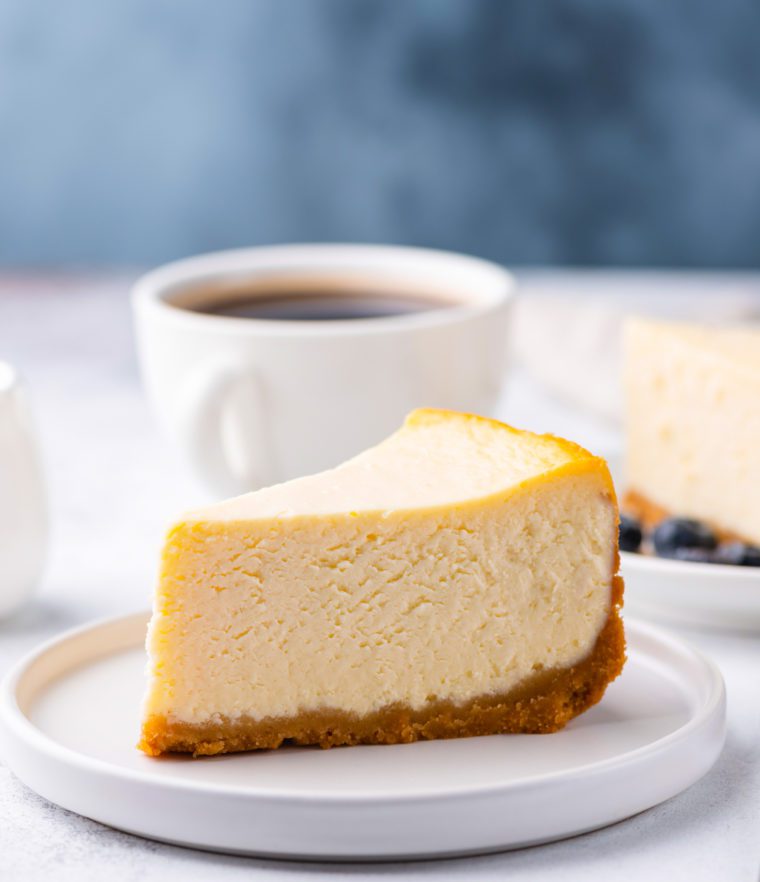
Cheesecake has always been my husband Michael’s favorite dessert. I remember when I first met my future mother-in-law over 20 years ago, she told me the key to her son’s heart was through his stomach—and he could be persuaded to do just about anything for a slice of NY cheesecake. Fortunately, I had just graduated from culinary school, so I had a little advantage in both winning his heart and perfecting my cheesecake recipe!
I know making cheesecake can seem a little intimidating. It’s a custard dessert that needs careful baking in a water bath to prevent cracking and to get that perfect, creamy consistency. But don’t let that scare you off. With a few pointers and a tried-and-true recipe, even beginners can whip up a dense, rich, and crack-free cheesecake. This is the kind of tradition-worthy dessert that rivals the best New York delicatessens—and who knows, it might even help you win someone over!
“I made this for my family at Christmas time and everyone LOVED it! I had never made a cheesecake before. The instructions were simple and easy for beginners. I am now tasked with making this for birthdays and holidays!”
What You’ll Need To Make New York Cheesecake
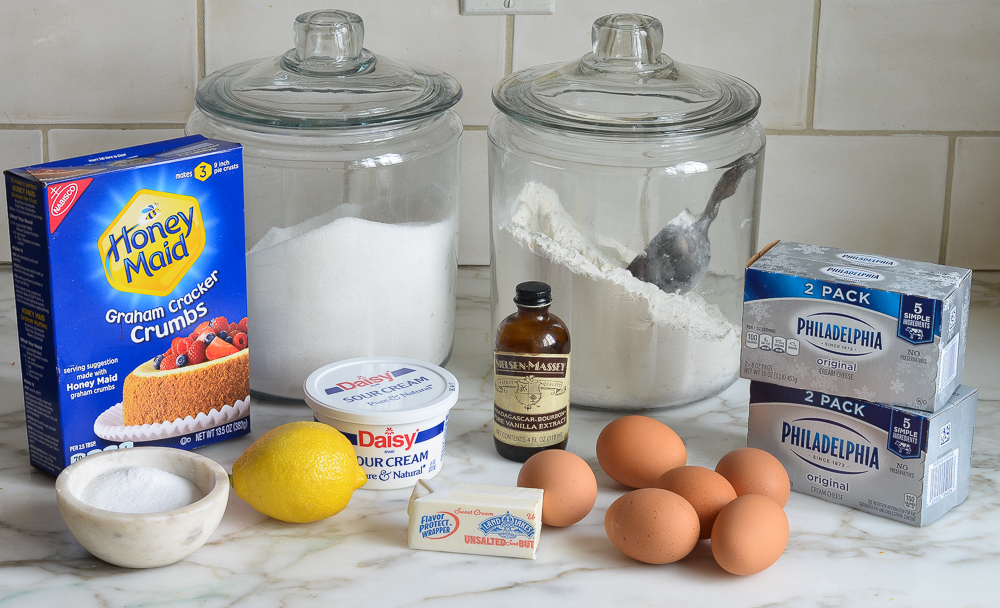
- Graham cracker crumbs: Forms the base of the crust, providing a sweet, crumbly texture.
- Butter: Binds the graham cracker crumbs together and adds richness to the crust.
- Sugar: Sweetens both the crust and the filling, balancing the tang of the cream cheese and lemon.
- Salt: Enhances the flavors of both the crust and filling.
- Cream cheese: The key ingredient of the filling, it provides the rich, creamy texture and tangy flavor. I recommend using a good brand, like Philadelphia.
- All-purpose flour: While it may seem unusual in a cheesecake, the flour is the secret to success. A little starch helps prevent cracking and makes the filling lighter and fluffier.
- Vanilla extract: Adds warmth and enhances the sweetness of the filling.
- Lemon zest and juice: Adds a subtle brightness and tang that cuts through the richness of the cream cheese.
- Eggs: Give the cheesecake its structure and help it set while maintaining a smooth texture.
- Sour cream: Adds extra creaminess and a slight tang, balancing the sweetness.
- Jump to the printable recipe for precise measurements
Key Equipment
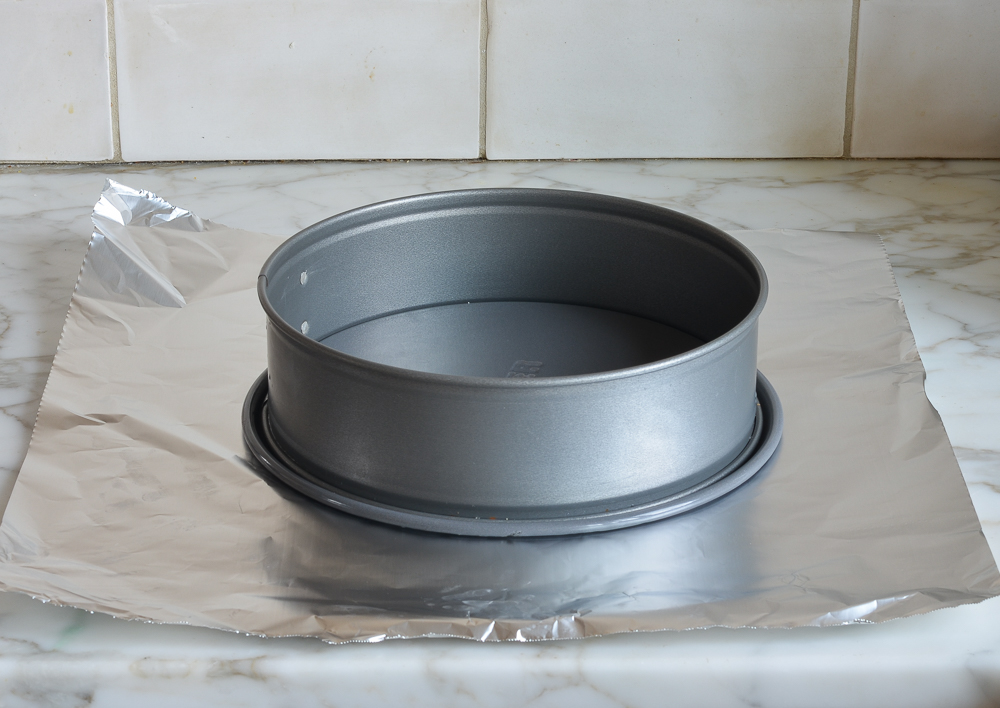
You’ll need a 9 or 10-inch springform pan and 18-inch heavy-duty aluminum foil. The springform pan features sides that can be removed from the base, so you can release the cake easily without having to flip the whole pan over (this would be a disaster with cheesecake). Springform pans, however, are notorious for leaking. Since the cheesecake bakes in a water bath, the foil prevents the water from seeping in during baking. If you’d like to try another technique that doesn’t require wrapping the pan in foil, you can place your springform pan inside a larger cake pan (see how it’s done here) or purchase a silicone wrap for your pan.
You will also need an electric mixer for whipping up the batter and a large roasting pan for the water bath.
Step-by-Step Instructions
Step 1: Preheat the Oven and Prep the Pan
Preheat the oven to 375°F.
Wrap the springform pan with one large piece of heavy-duty aluminum foil, covering the underside of the pan and extending all the way to the top. Repeat with another sheet of foil for insurance. Spray the inside of the pan with nonstick cooking spray.
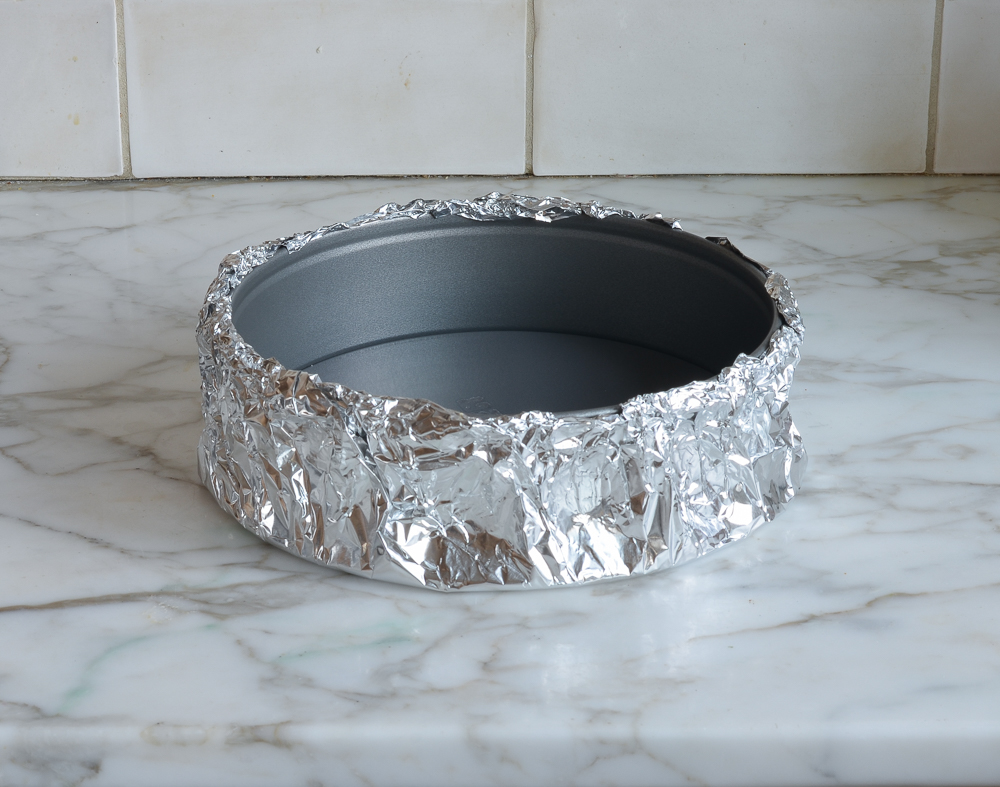
Step 2: Make the Graham Cracker Crust
In a medium bowl, combine the graham cracker crumbs, melted butter, sugar, and salt.
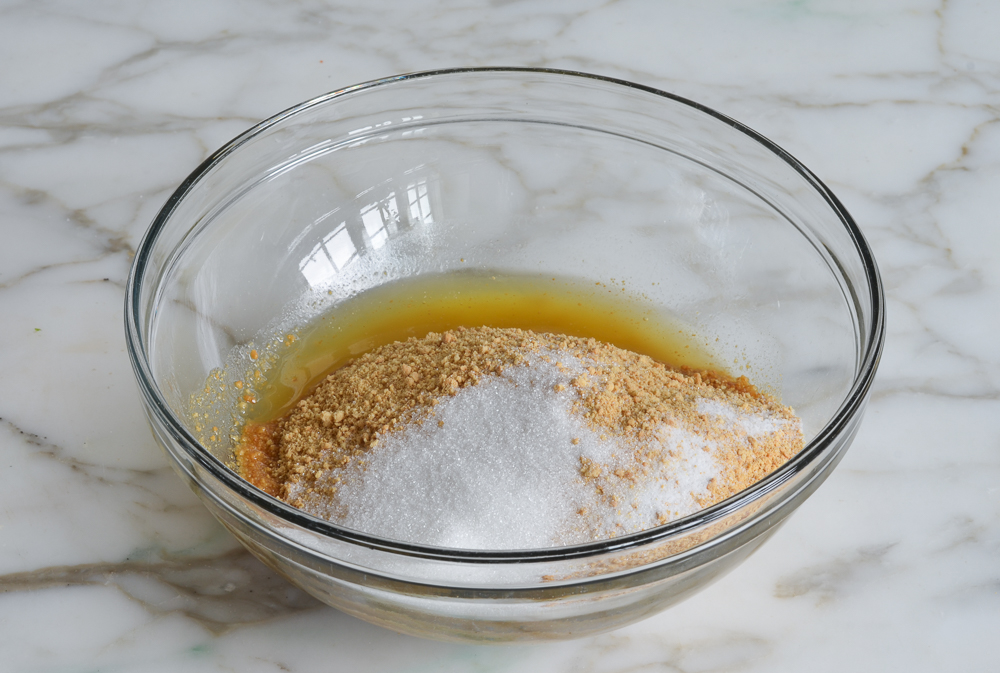
Stir until well combined.
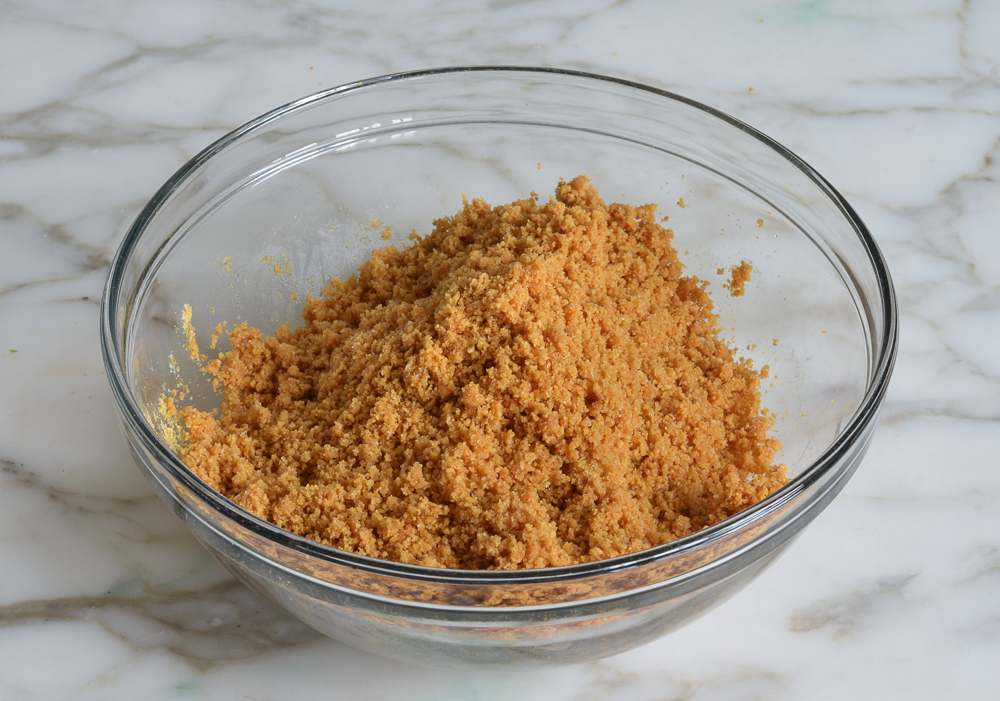
Press the crumbs into an even layer on the bottom of the prepared pan. Bake the crust for 10 minutes, until set. Remove the pan from the oven and set aside. Reduce the oven temperature to 325°F.
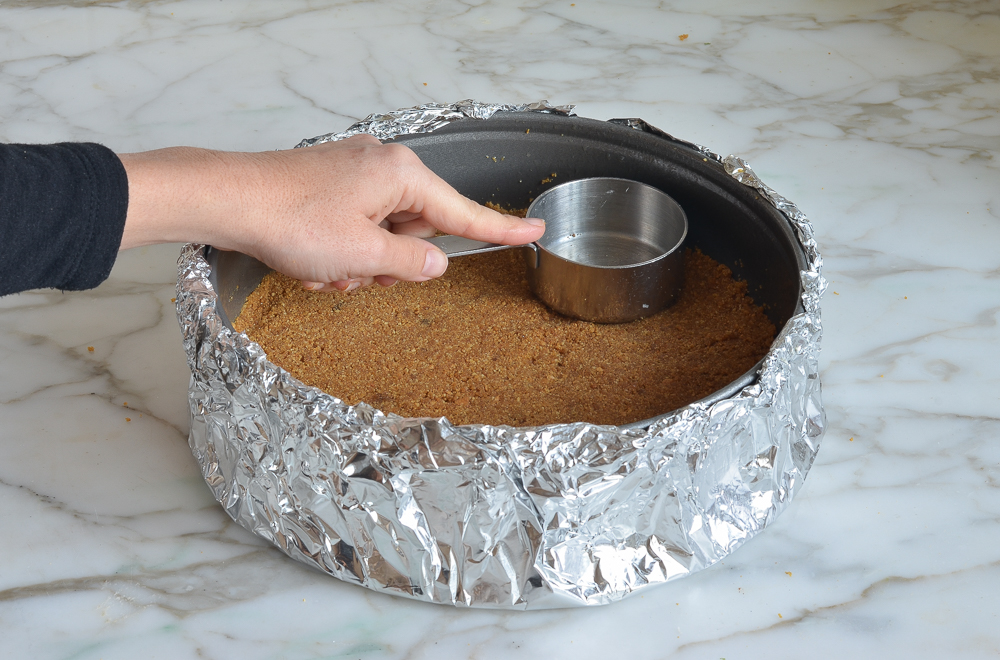
Step 3: Make the Cheesecake Batter
In the bowl of an electric mixer fitted with the paddle attachment or beaters, combine the cream cheese, sugar, and flour.
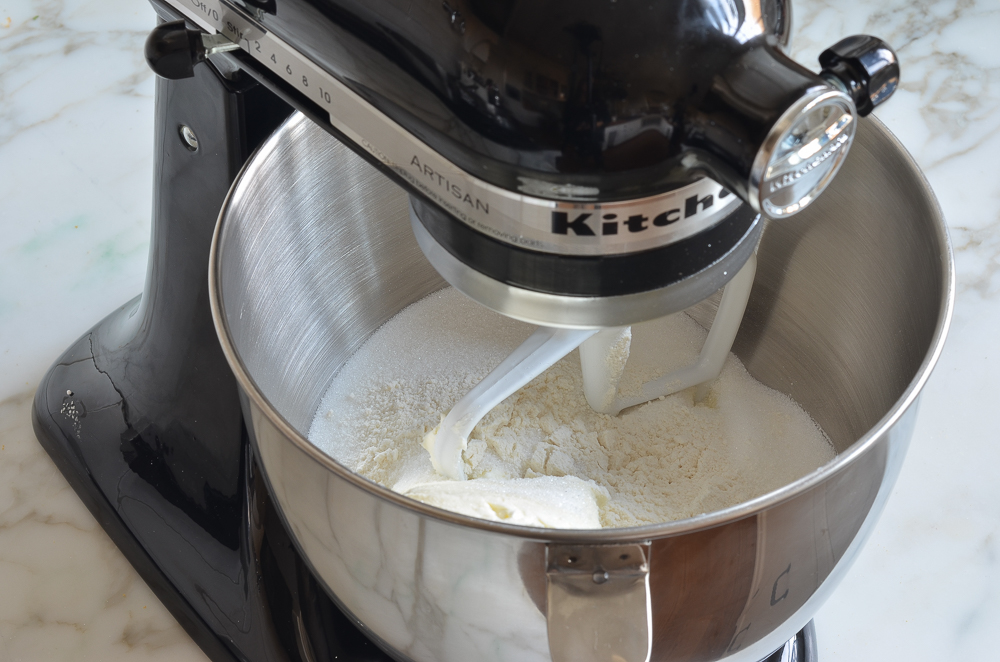
Beat on medium speed until just smooth, about 1 minute. Scrape the bottom and sides of the bowl to be sure the mixture is evenly combined.
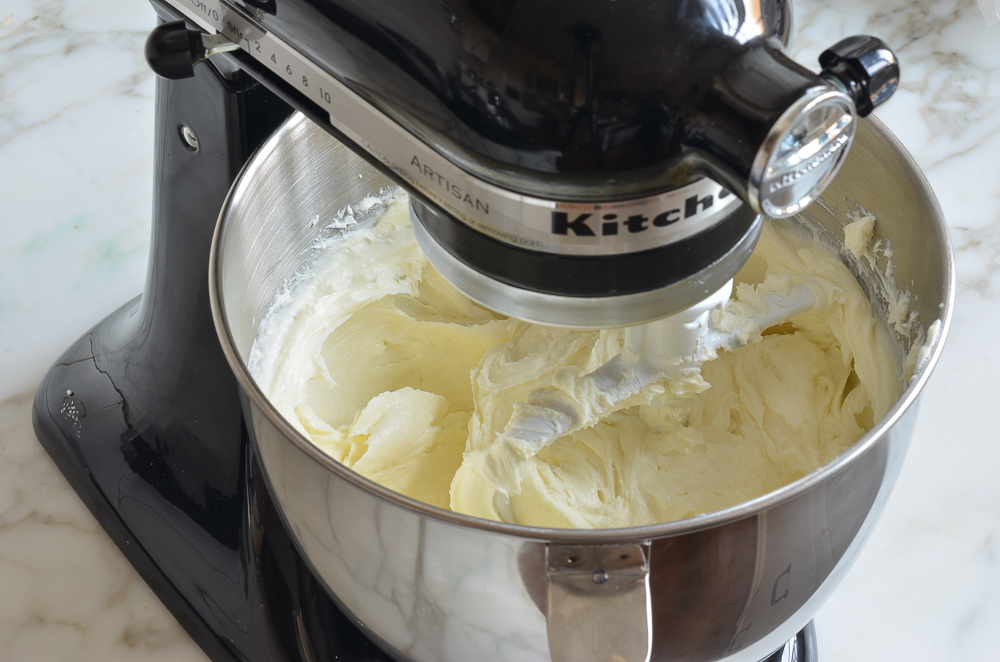
Add the vanilla, lemon zest, lemon juice, and salt; beat on low speed until just combined.
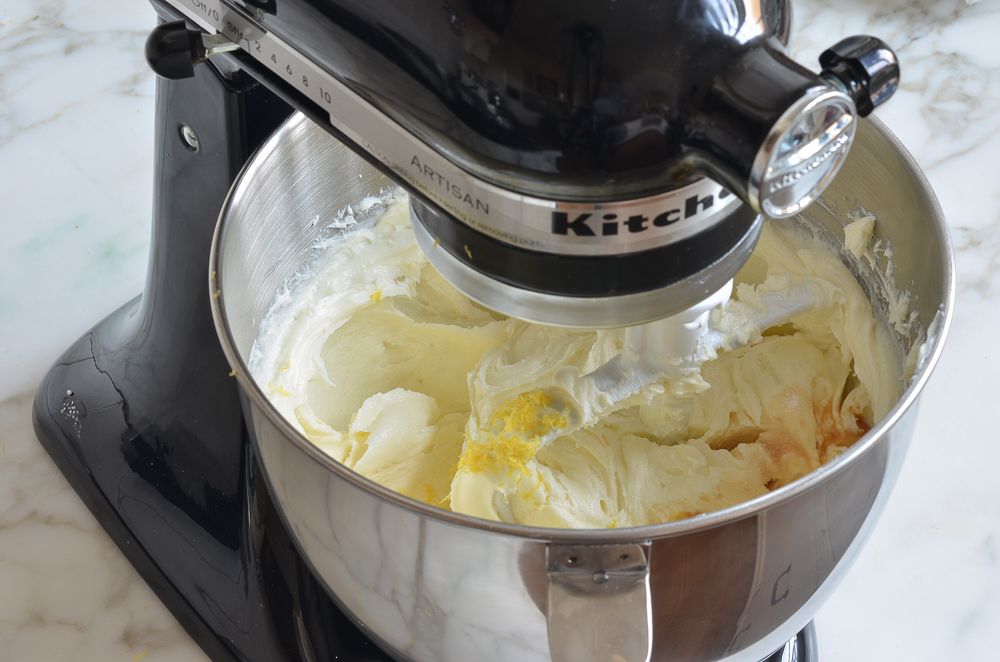
Add the eggs, one at a time, mixing on low speed until incorporated, scraping the bowl as necessary.
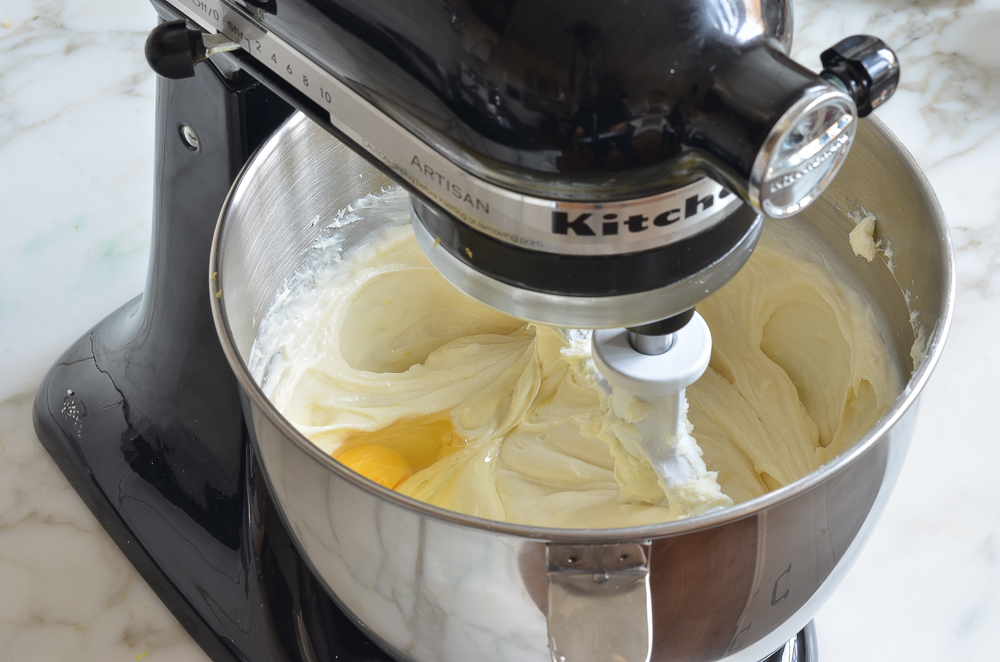
Mix in the sour cream.
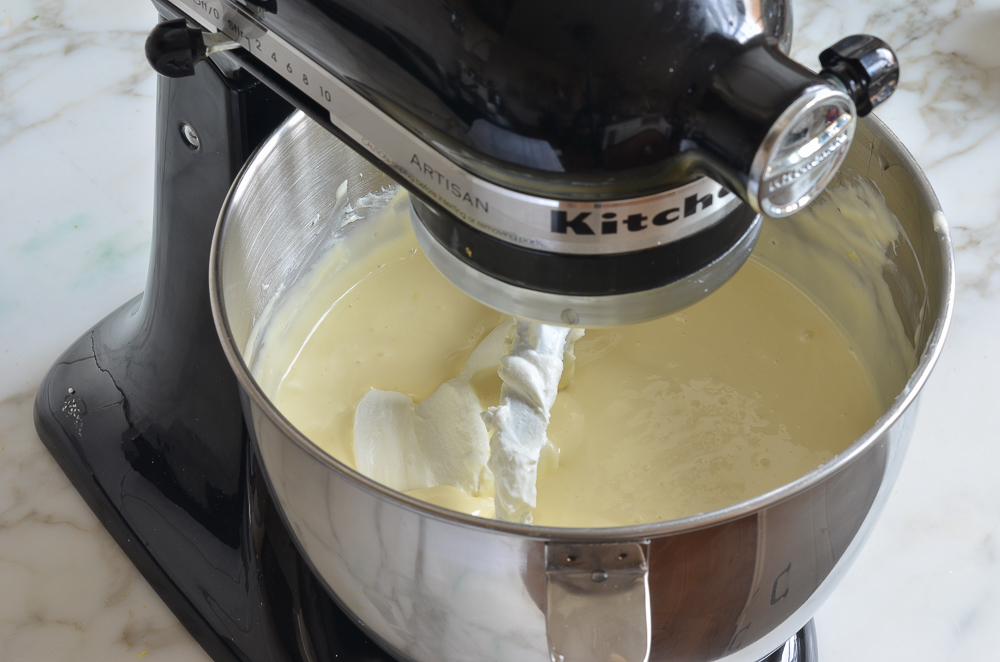
Make sure the batter is uniform but do not over-mix.
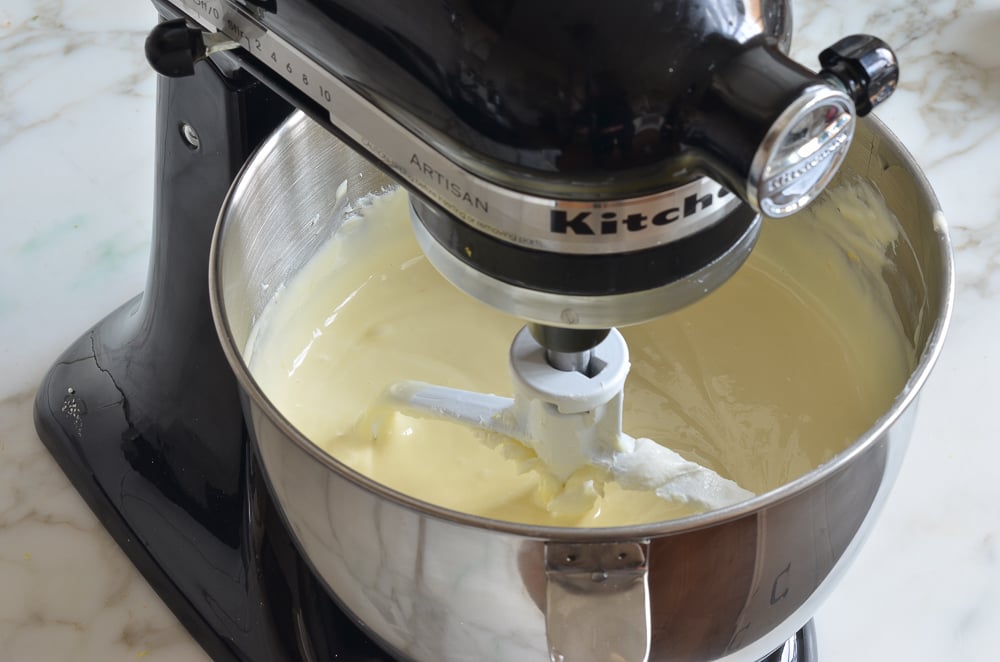
Pour the batter on top of the crust.
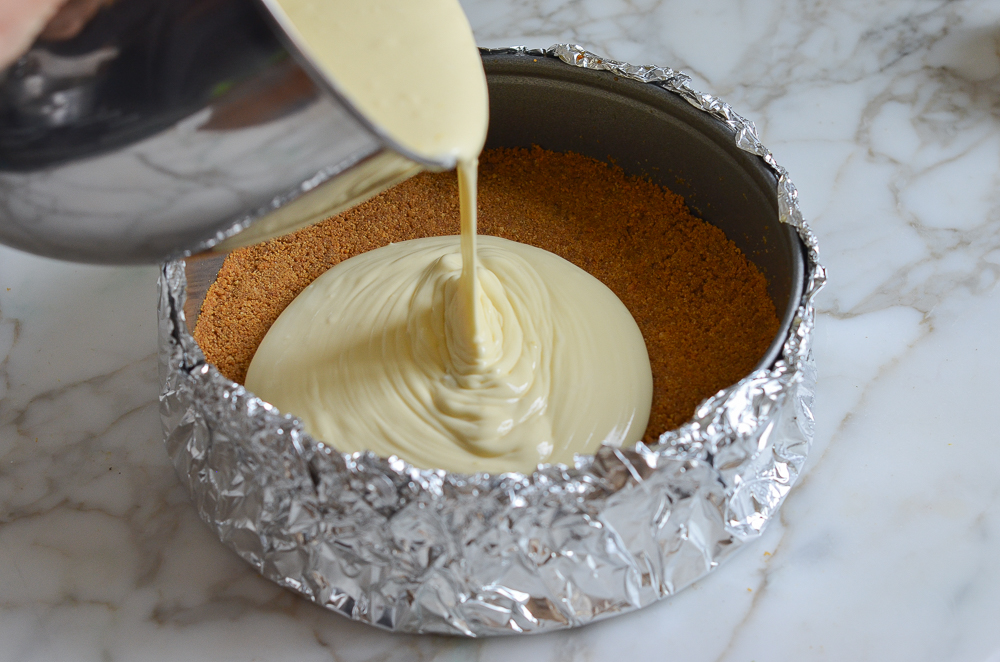
Step 4: Bake
Set the unbaked cheesecake in a large roasting pan. Pour boiling water into the roasting pan until it comes about one inch up the side of the cake pan. The water bath (also called a bain marie) regulates the temperature and keeps the cheesecake baking at an even, low heat. The steam/humidity created by the water bath also protects the cheesecake from drying out and cracking.
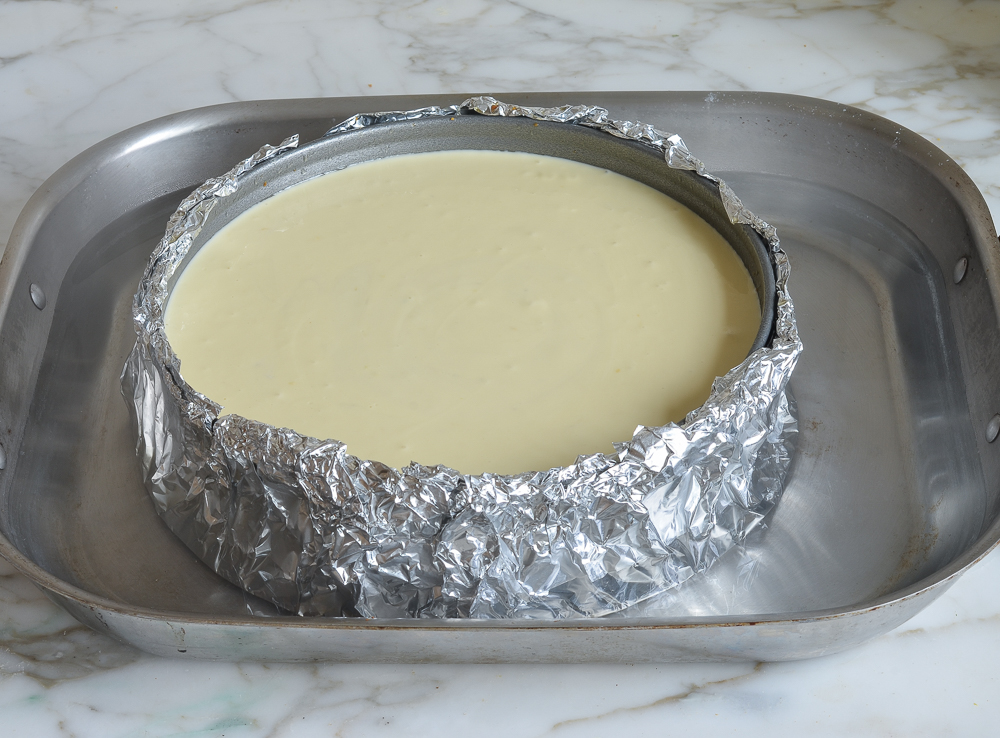
Bake until the cake is just set, 1 hour and 30 minutes to 1 hour and 45 minutes. The cake should not look liquidy at all but will wobble just a bit when the pan is nudged; it will continue to cook as it cools.
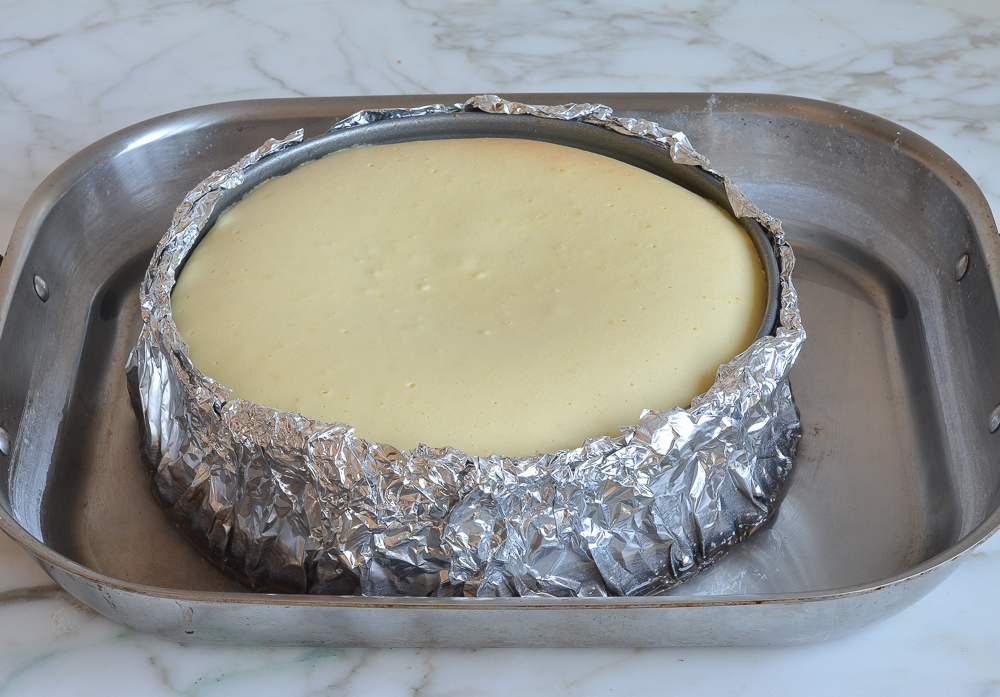
Step 5: Cool
Carefully remove the roasting pan from the oven and set it on a wire rack. Cool the cheesecake in the water bath until the water is just warm, about 45 minutes. Remove the springform pan from the water bath, discard the foil, and transfer the cheesecake to the refrigerator to cool for at least 8 hours or overnight.
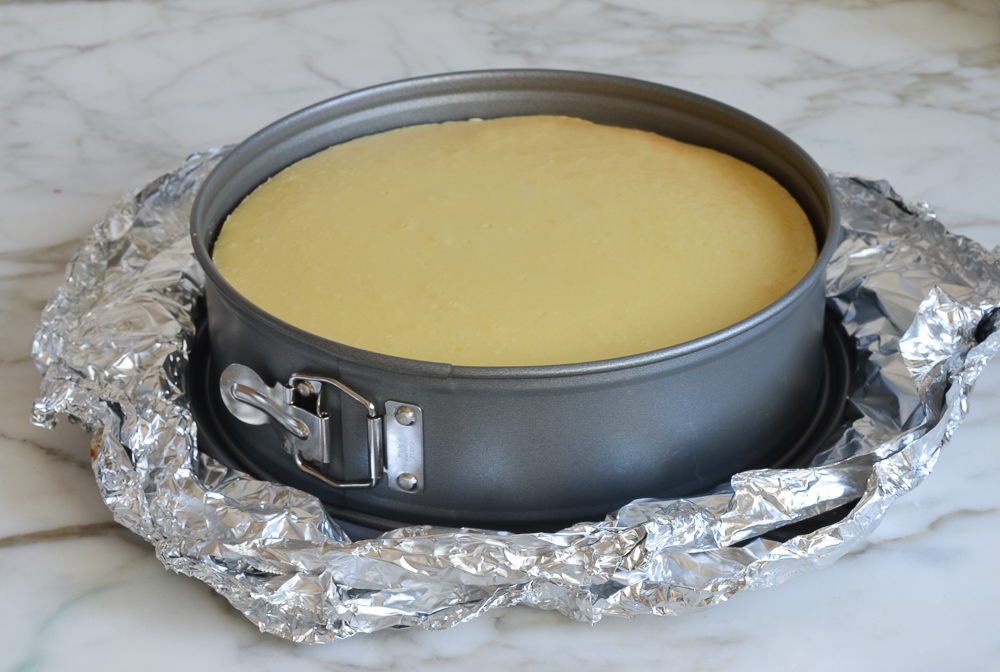
Remove the sides of the springform pan. You can serve the cheesecake right from the base of the springform pan. Or, if you’d like to transfer it to a serving platter, run a long, thin spatula between the crust and the pan bottom, and then use two large spatulas to transfer the cheesecake to a serving dish. Slice with a sharp knife, wiping the knife clean between slices. Serve with berry sauce, if you like.
Video Tutorial

You May Also Like
Classic New York Cheesecake
Think making cheesecake is difficult? Think again! This foolproof recipe delivers a cheesecake that’s dense, rich, and creamy—rivaling those from New York’s most beloved delis—and it’s simple enough for beginners to master.
Ingredients
For the Crust
- 1½ cups graham cracker crumbs, from 12 whole crackers
- 5 tablespoons unsalted butter, melted
- 2 tablespoons sugar
- ⅛ teaspoon salt
For the Filling
- 32 oz (four 8-oz blocks) cream cheese, at room temperature
- 2 cups sugar
- 3 tablespoons all-purpose flour
- 4 teaspoons vanilla extract
- 1 teaspoon packed lemon zest, from 1 lemon
- 2 teaspoons fresh lemon juice, from 1 lemon
- ¼ teaspoon salt
- 6 large eggs
- ½ cup sour cream
- Special equipment: 9- or 10-inch springform pan; 18-inch heavy-duty aluminum foil (see Pro Tip)
- Berry sauce, for serving (optional)
Instructions
For the Crust
- Preheat the oven to 375°F and set an oven rack in the lower middle position. Wrap a 9- or 10-inch springform pan with one large piece of heavy-duty aluminum foil, covering the underside and extending all the way to the top so there are no seams on the bottom or sides of the pan. Repeat with another sheet of foil for insurance. Spray the inside of the pan with nonstick cooking spray.
- Make the crust: In a medium bowl, combine the graham cracker crumbs, melted butter, sugar, and salt. Stir until well combined. Press the crumbs into an even layer on the the bottom of the prepared pan. Bake the crust for 10 minutes, until set. Remove the pan from the oven and set aside.
- Reduce the oven temperature to 325°F. Set a kettle of water to boil.
- Make the batter: In the bowl of an electric mixer fitted with the paddle attachment or beaters, beat the cream cheese, sugar, and flour together on medium speed until just smooth, about 1 minute. Scrape the bottom and sides of the bowl to be sure the mixture is evenly combined. Add the vanilla, lemon zest, lemon juice, and salt; beat on low speed until just combined. Add the eggs, one at a time, mixing on low speed until incorporated, scraping the bowl as necessary. Mix in the sour cream. Make sure the batter is uniform but do not over-mix.
- Check to make sure your oven has cooled to 325°F, then set the cheesecake pan in a large roasting pan. Pour the batter on top of the crust. Pour the boiling water into the large roasting pan to come about 1 inch up the side of the cake pan. Bake until the cake is just set, 1 hour and 30 minutes to 1 hour and 45 minutes. (If the cheesecake starts to look too golden on top towards the end, cover it loosely with foil.) The cake should not look liquidy at all but will wobble just a bit when the pan is nudged; it will continue to cook as it cools. Carefully remove the roasting pan from the oven and set it on a wire rack. Cool the cheesecake in the water bath until the water is just warm, about 45 minutes. Remove the springform pan from the water bath and discard the foil. If necessary, run a thin-bladed knife around the edge of the cake to make sure it's not sticking to the sides (which can cause cracks as it cools), then cover with plastic wrap and transfer to the refrigerator to cool for at least 8 hours or overnight.
- For serving: Remove the sides of the springform pan. Serve the cheesecake right from the base of the pan; or, to transfer it to a serving platter, run a long, thin spatula between the crust and the pan bottom, and then use two large spatulas to carefully transfer the cheesecake to a serving dish. Slice with a sharp knife, wiping the knife clean between slices. Serve with berry sauce, if you like.
- Make Ahead: The cheesecake can be made and stored in the springform pan in the fridge, tightly covered with plastic wrap, up to two days ahead of time.
- Freezer-Friendly Instructions: The cheesecake can be frozen for up to 3 months. To freeze, place the cake in the freezer briefly, unwrapped, to firm it up. Then double-wrap it tightly with aluminum foil or plastic freezer wrap, or place it in heavy-duty freezer bag. Thaw in the refrigerator the night before you plan to eat it.
- Pro Tip: Springform pans are notorious for leaking. Since a cheesecake bakes in a water bath, the foil prevents the water from seeping in during baking. Please do not attempt to use standard 12-inch (30cm) aluminum foil – you can’t have any foil seams on the bottom or sides of the pan. No matter how well (or how many times) you wrap the pan, if there are seams exposed to the water, the water will find a way in. Even when wrapped properly, you can occasionally get some condensation inside the foil. If this happens, don’t worry – the crust is likely just a bit moist around the edges. Simply remove the sides of the springform pan before refrigerating and let it dry out in the refrigerator.
Nutrition Information
Powered by ![]()
- Per serving (10 servings)
- Serving size: 1 slice
- Calories: 659
- Fat: 43 g
- Saturated fat: 24 g
- Carbohydrates: 59 g
- Sugar: 49 g
- Fiber: 1 g
- Protein: 11 g
- Sodium: 464 mg
- Cholesterol: 233 mg
This website is written and produced for informational purposes only. I am not a certified nutritionist and the nutritional data on this site has not been evaluated or approved by a nutritionist or the Food and Drug Administration. Nutritional information is offered as a courtesy and should not be construed as a guarantee. The data is calculated through an online nutritional calculator, Edamam.com. Although I do my best to provide accurate nutritional information, these figures should be considered estimates only. Varying factors such as product types or brands purchased, natural fluctuations in fresh produce, and the way ingredients are processed change the effective nutritional information in any given recipe. Furthermore, different online calculators provide different results depending on their own nutrition fact sources and algorithms. To obtain the most accurate nutritional information in a given recipe, you should calculate the nutritional information with the actual ingredients used in your recipe, using your preferred nutrition calculator.

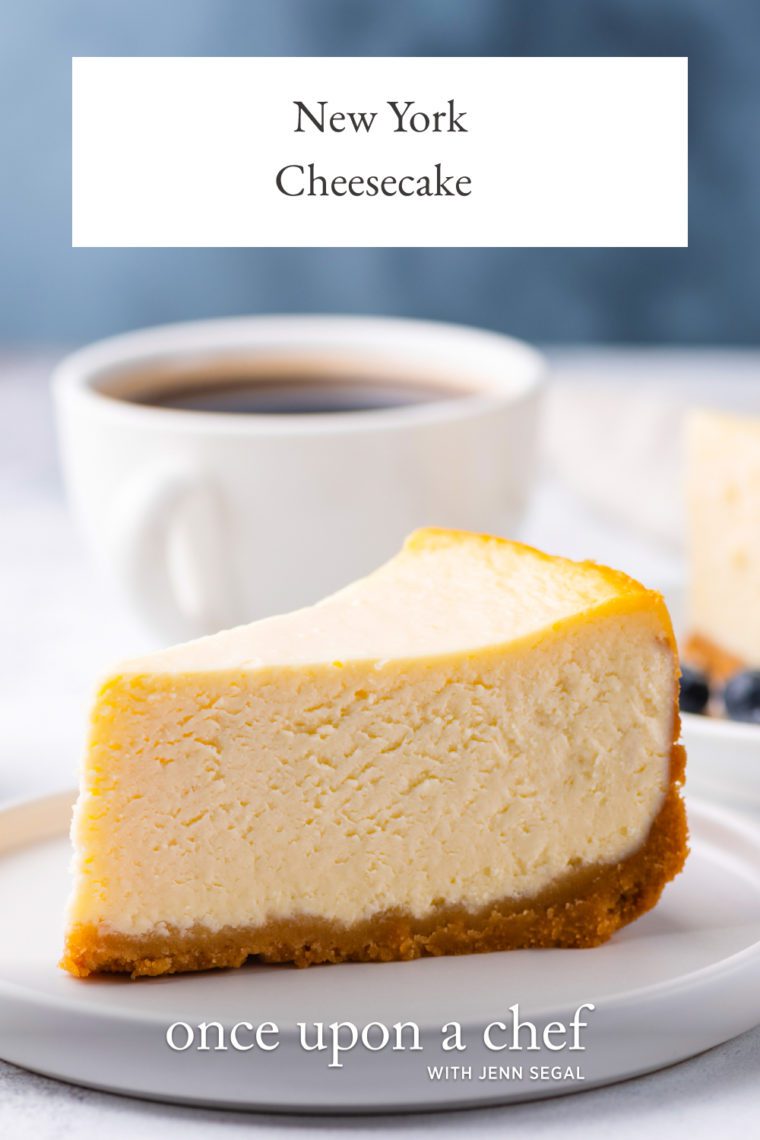
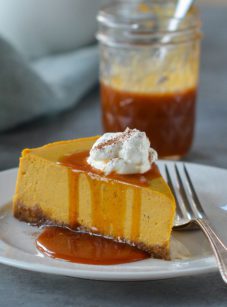

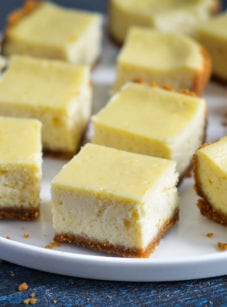
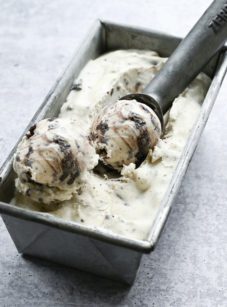
Its wonderful! I’ve made it any number of times.
I did exactly as the recipe but it still cracked and coloured on the top. Took it out after 1hour 20 minutes as it was definitely done. A bit disappointed on the appearance but will try again at a slightly lower temperature next time.
Jane – Sounds like your oven temp may be off. Get an oven thermometer and verify it’s heating to the temp you need it to and not going over. Hope this helps!
OMG. Raves all the way around for this recipe! Looked at so many different ones and so happy I settled on this one.
Forgot my niece’s oven was convection and panicked when I remembered at about an hour. It was pretty brown on top. Thought for sure it would be dry and yucky. But no!
The 2nd “backup” cake turned out perfect BUT got broken into the night before the party. LOL. Both were absolute perfection.
Made a simple strawberry sauce with water, sugar, and a dash of vanilla.
Everyone couldn’t stop raving about it!
So glad it was a hit (and the cake “break-in” made me laugh)! 🙂
I love to bake, but was years before I tried making a cheesecake. This is the 3rd recipe we’ve tried. It is absolutely phenomenal! The only thing I did different was no crust. We just don’t care for a crust. It was super easy to follow the recipe and came together very quickly. Baked up wonderful. This is definitely the recipe I will be using from now on!
This was my first cheesecake ever. Holy cow!! It came out perfectly. My husband couldn’t stop raving about it. As good as any restaurant cheesecake we’ve eaten.
I made your New York cheesecake it came out perfect every person who had it said it was the best cheesecake they have ever had I give you five stars thank you so much
Perfect recipe! This cheesecake is amazing, best recipe for cheesecake I’ve used. Big hit, family loved it, none left over. You might want to make two if you’re serving more than a few people.
Made this cheesecake for July 4th BBQ and it was delicious and people wanted the recipe. I have one question though – I followed directions to the letter however my graham cracker crust stuck to the bottom. Any thoughts on what I did wrong?
Hi Joann, sorry to hear the crust stuck to the pan! Did you spray the inside of the pan (bottom and sides) with non-stick spray?
I use a sheet of parchment paper to make sure it doesn’t stick. Hope that helps!
Insert all the superlatives ever right here…this cheesecake (with the berry sauce) was spectacularisimo! My guests swooned. I did too.
I used Nairn’s GF Oat Grahams and GF Jules All-purpose gluten free flour (both ordered from Amazon) to make this a gf cheesecake my niece could eat. And still the whole thing was the best cheesecake and berry sauce all my guests had ever eaten (and that included some memorable cheesecake eating experiences within the crowd).
Unanimous vote, the berry sauce for the big win!
I forgot to rate your recipe five stars in my last review. Sorry.
I’ve been baking for 50 years. I’ve tried a lot of bad recipes in that time. The recipes online are often a sad joke. Just being honest here. The directions leave things out, and often make mistakes. Then the final result is an expensive, time wasting disaster. Not so with this cheesecake. Directions perfect! Cheesecake perfect! You know what you’re doing Jenn Segal! Thanks so much for the awesome free recipe! You need to teach the Food Network how to do it. So many of their recipes are duds. I have made a few good things from that website. But, when deciding to try a new one with them I go through the recipe and use my own good judgment in figuring out if it is a bad recipe. Wish you much success. You obviously have worked hard. You deserve it!
I don’t understand the recipe because I don’t see where it says the amount of each ingredient.
Hi Cole, It sounds like you are just looking at the portion of the page that has the pictures with some instructions underneath. If you scroll down a bit to under the pictures, you’ll find the full recipe. Alternatively, at the very top of the page, to the right of the recipe name, you’ll see an icon that looks like a notepad – if you click on that, it will take you directly to the recipe. Hope that clarifies!